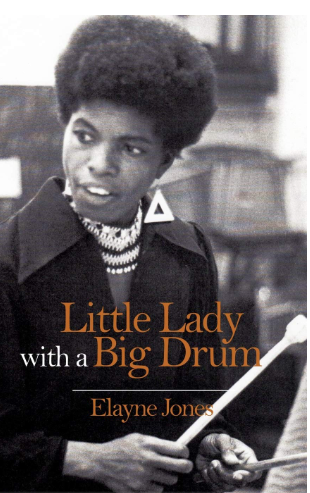News Americas, NEW YORK, NY, Sat. Dec. 24, 2022: A Caribbean American percussionist who was not only a rare woman among the orchestral percussionists of her time but also helped lead a generation of Black musicians in confronting racism in the classical music industry has passed away at 94.
Elayne Viola Jones, who was born to Caribbean immigrants from Barbados in Harlem, died from dementia at her home in Walnut Creek, California on Dec. 17, 2022, according to her daughter Cheryl Stanley and the New York Times.
Jones was born on Jan. 30, 1928, in Harlem, the only child of Cecil Jones, a porter and then a subway conductor and Ometa Jones who dreamed of becoming a professional pianist.
Her maternal grandfather owned a rum shop in Barbados where her mother, Ometa, played piano. “Everyone loved her playing, so she was sent to New York to study music and become a concert pianist,” Jones explained to the Percussive Arts Society once. But like many other women of color in the early 20th century, she wound up working as a maid in New York City.
“My mother always said to me, ‘Laynie, you’re going to do something respectable. You’re not going to clean white people’s floors!’ So I started studying piano at the age of six,” Jones told the Society “At first, I just wanted to go outside and play ball with the boys. But soon I became so involved in the music that I didn’t want to stop practicing. I had a good ear and could retain almost anything I heard.”
Growing up, Jones sang in the choir at St. Luke’s Episcopal Church, preferring to sing harmony. “Choir practice was a happy time for me,” she recalled. “After rehearsal was over on Fridays, we’d go to the ‘Rennie’ [Renaissance Ballroom] or the Savoy and listen to music and dance.” This is where Jones was introduced to the music of Duke Ellington, Count Basie, and even Frank Sinatra.
Jones also attended concerts by the New York Philharmonic at nearby Lewisohn Stadium, a Greco-Roman amphitheater built on the campus of City College of New York. “Since I had no brothers or sisters, I was used to going places by myself,” she explains. “As I tell other people, you can’t expect your children to learn unless you let them go out and explore. Fortunately, I had that curiosity, maybe because I was an only child.”
After attending an all-girls junior high school in Harlem, where she was in many advanced classes, Jones was accepted into the Music and Art High School thanks to her piano skills. Students from all five boroughs traveled from across New York City to attend the elite high school.
“All the piano students also had to play an orchestral instrument,” Elayne explains. “After seeing the orchestra, I was drawn to the violin. But the teacher, Isadore Russ, told me I was ‘too skinny’.”
How did she choose percussion? “Racism,” Jones said once with a wry smile. “Mr. Russ handed me a pair of drumsticks and said, ‘We all know that Negroes have rhythm.’ When my family would visit Barbados during my childhood, I loved the music and the dancing and the drummers, but it never entered my mind that I would play drums someday.”
Jones was soon playing timpani in her high school orchestra, while continuing to sing and play the piano. “I realized that my singing made me a good timpanist,” she explained. “I also realized the music I studied in school was played by white people, while the music I heard and danced to was played by Negroes.”
One day, her mother saw a notice in the paper that Duke Ellington was going to give scholarships to six outstanding students from throughout the five boroughs who would be graduating that year. “I didn’t think I was good enough, but I was one of the winners!” (Elayne was the only female, only black, and only percussion scholarship recipient.) She graduated from the High School of Music and Art, now known as the LaGuardia High School of Music and the Arts (aka the Fame high school), in June 1945 with awards for both her music and athletic abilities.
Thanks to this scholarship, Jones was able to attend the prestigious Juilliard School of Music. This is where she had the opportunity to study with New York Philharmonic timpanist Saul Goodman, one of five inductees into the inaugural PAS Hall of Fame class in 1972.
Jones also remembers studying with Morris “Moe” Goldenberg, inducted into the PAS Hall of Fame two years after Goodman. “I took xylophone lessons from Moe. But it was during ensemble class where we learned to play all the percussion instruments.”
Jones graduated from Juilliard in 1949, and that summer, she attended the Tanglewood Music Festival in Massachusetts, performing in the student orchestra. During her time there, she studied with Roman Szulc, then-timpanist with the Boston Symphony Orchestra, as well as other musicians such as Leonard Bernstein and Aaron Copland. “The six weeks at Tanglewood were one of the happiest experiences of my life,” Elayne remembers fondly.
When she returned to New York City, it was time to find employment in her chosen field. Jones auditioned for the timpani chair of the New York City Opera, as their current timpanist, Alfred Howard, was leaving for another position. “They didn’t want to hire me because I was black and I was a woman,” she recalled, “and I wasn’t Italian! But Goodman stepped in on my behalf and reminded them that I had played the best audition. Al played the rehearsals of Strauss’s ‘Der Rosenkavalier,’ but I had to play the performance! I think they wanted me to fail. So I sat in the audience during the rehearsals while Al played timpani, and I listened to everything.” In October 1949, Jones was the first black person to play in an opera orchestra, and one of only two women in the pit that night. That performance was the beginning of an eleven-year career with NYCO.
In addition to performing in New York, NYCO also toured around the country. “I remember my first trip to Chicago in 1950,” Jones told Lauren Vogel Weiss. “Blanche Birdsong was the harpist and the only other woman in the orchestra. She and I went over to the Chicago Opera House early to get our instruments ready. But the doorman at the stage door wouldn’t let me in because I was black. He said, ‘We don’t let Nigras in the theater. Why don’t you go to the South Side where you belong?’ Some things make me cry,” she says, after a pause, “and there are other things that I can’t do anything about. Things like this made me more sensitive. I wasn’t just playing music; I was making a statement. This would be my new objective: to try to change the way women and blacks were treated.”
This did not even take into account the difficulties Jones ran into when the musicians would arrive at a hotel. In many cities, she was not allowed to stay in the same hotel with other members of the orchestra. Sometimes she would have to stay in a “colored hotel,” or a local YWCA with a few other women from the chorus.
There were also dilemmas that today’s musicians could not fathom, especially when it came to segregation and equal rights. For example, would Jones pay her “traveling dues” to the white musicians union, which represented symphonic musicians, or to the black musicians union, which represented jazz musicians? “I was the first black musician who played opera,” she explained once. “I didn’t want to pay the racist white union, but that is what I had to do.”
She also remembers playing Carl Orff’s “Carmina Burana.” During her years with the opera orchestra, Jones freelanced around the New York metropolitan area. She played percussion in multiple shows on Broadway, including Carousel, South Pacific, and Green Willow. And she met her future husband, George Kaufman, while playing drum set at a jazz gig in the Adirondacks in 1952. (They were married for more than a decade and had three children, Stephen, Harriett, and Cheryl.)
In September 1958, Jones had a chance to perform with the New York Philharmonic. In June 1960, Jones left the New York City Opera and soon became involved with the newly formed American Symphony Orchestra, organized and conducted by Leopold Stokowski. She recalls the evening when she, trumpet player Robert Nagel, and bass player Stuart Sankey met with Stokowski in his Fifth Avenue penthouse. “He asked the three of us to be the nucleus of his new project—without auditioning!” Elayne joined the ASO, an ensemble intended to demystify classical music and make it accessible and affordable for all audiences, playing with them from 1961 to 1972.
In the mid-1960s, Jones was also involved in the formation of the Symphony of the New World, a training orchestra to give black musicians the opportunity to play orchestral repertoire, and the first racially integrated orchestra in the United States. Benjamin Steinberg, a violinist in the NBC Symphony Orchestra, served as its first Music Director.
Around this time, Jones was concerned that there were not more women or people of color in orchestras. She and several other people, including Alfred Brown, an African-American violinist who graduated from the Curtis Institute of Music, Harry Smyles, an African-American oboist who graduated from the Cleveland Institute of Music, and Steinberg, met at the musicians union to try to figure out a solution. “What if it was impossible to know who was auditioning?” They were instrumental in creating the concept of a “blind audition” played behind a screen, so that orchestra committees would not know if the people auditioning were black or white, or male or female, a tradition that continues to this day.
In October 1971, Jones was invited to play with the World Symphony Orchestra—over 140 musicians from 64 nations—under the direction of Arthur Fiedler. They performed at Carnegie Hall, the gala opening of Walt Disney World in Florida, and for the opening of the Kennedy Center in Washington, D.C.
In 1972, Saul Goodman retired from the New York Philharmonic after 47 years as Principal Timpanist. Dozens of potential replacements, including Elayne Jones, auditioned for the position. When no one was hired, Roland Kohloff, then timpanist with the San Francisco Symphony, and a former student of Goodman, auditioned a few weeks later and was hired by the Philharmonic, leaving the timpani chair in San Francisco available.
When she accepted the job on the West Coast, Jones received a very special note from her former conductor: “Dear friend, For you I am glad that you will go to San Francisco and for us and me, I am sorry. I am sure San Francisco will enjoy your great Tympani playing.” The note was signed by Leopold Stokowski.
One of the members of the percussion section during that time was another former Goodman student, PAS Hall of Famer Tony Cirone.
After two seasons with the symphony, Jones was not given tenure. She sued the symphony for racial discrimination, playing her third (and last) season with them while the case went through the court system.
In 1975, Kurt Herbert Adler was in charge of the San Francisco Opera, and although the symphony was the de facto opera orchestra, he decided to keep Jones as the timpanist for the opera, a position she would hold for the next 23 years. And in 1980, when Davies Symphony Hall opened, the SFO hired its own orchestra, including new Principal Percussionist and Associate Timpanist, Rick Kvistad, who is in his 40th season with the Opera.
In 1998, at age 70, Jones retired from the SFO to spend more time with her family. She also gave hundreds of lectures at schools, in the Bay Area, Barbados, and all around the country.
Jones also taught a few private timpani students over the years. Another “retirement project” was her 310-page autobiography, Little Lady With a Big Drum (Advanced Publishing LLC).









